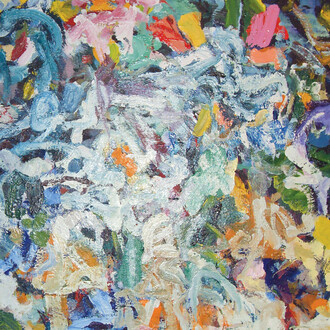Amaranth Ehrenhalt, Sonia Gechtoff and Liz Whitney Quisgard emerged during the Abstract Expressionist era of the 50s and 60s, and it's no exaggeration to say that they were eclipsed by their male counterparts. These three have not only outlived many of their peers, but they have blossomed during the decades under the radar: they show internationally and nationally, and their work is collected worldwide.
Over 85 - Still Creating marks a turning point, as attention is now being paid to the less well-known, but certainly not less important Abstract Expressionists who often happen to be female. A recent article "Finally, an Exhibition Devoted to the Women of Abstract Expressionism" posted by Jillian Steinhauer (Hyperallergic.com, September 2015) signals the correction to come, yet you can see Over 85--Still Creating, a showcase of three irrepressible, Abstract Expressionist women painters now. Synthesizing emotional impressions into the physical, Amaranth Ehrenhalt creates sculptures, paintings, fabric designs, watercolors, prints, tapestries and photographs; beginning with color or responding to "an idea has been bothering me," often working in series to fully capture what needs to be said. Inspired by Classical Jazz, she contrasts "light notes and heavy notes that touch your entire being."
Marcia G. Yerman's "A Conversation with Amaranth Ehrenhalt" (The Huffington Post, March 2012) surveys this chameleon-like artist's output, discovering that Amaranth also writes! Ehrenhalt's "Cafe Society" (Vogue, September 2012) reminisces about her friendship with Alberto Giacometti and captures the tone of the Parisian art scene in the 50s when Sonia Delaunay became her patron. Currently, Amaranth is working on a series of short pieces about Abstract Expressionists that will be published on Amazon. In 2014, she exhibited in "Shifting Ecologies" at The Painting Center, and "Colorimetry" at Galerie102 in Ojai, California. Sonia Gechtoff wants to "get into the work without overloading it," and her skill lies in painting ambiguous imagery without being repetitive.
Rooted in drawing, her paintings pivot on careful attention to edge and line. "The Beginning" (1960) recalls the fluid, blended, spun-cotton skies of El Greco; it was recently purchased by the Denver Art Museum. Jillian Steinhauer's Hyperallergic.com article names Sonia as one of the twelve women featured in the Spring 2016, Denver Art Museum show Women of Abstract Expressionism, curated by Gwen Chanzit. When Jillian asks about Gwen's impetus for the show, Gwen says, "I kept coming back to some female Abstract Expressionists whose paintings challenge the predomi-nately male-centric definition of the movement. Frankly, I was surprised that no major museum exhibition had yet been mounted."
Liz Whitney Quisgard covers surfaces and sculptures with a modified, wildly inventive pointillism that draws from Oriental carpets and Islamic designs. She eschews meaning and competing with the Ab-Ex patriarchs only seems to fuel her drive to unspool beauty, as her reach grows by the square inch and square foot every day. She remembers being relieved to have a dealer and flattered rather than insulted in the early 60s when Andre Emmerich told her, "Liz, if you had been a man I would have taken you on two years ago." Liz is exhibiting in "Middle Eastern Influences" with Fariba Abedin at the Museum of Geometric and MADI Art in Dallas, Texas through January 3, 2016, and in "Vivid" at the Fort Smith Regional Art Museum, Fort Smith, Arkansas; November 14-January 18, 2016.
In the vanguard of showcasing female Abstract Expressionists, Over 85--Still Creating dovetails with the upcoming "Women of Abstract Expressionism", opening June 12 at the Denver Art Museum. Steinhauer quoting Gwen Chanzit states it best; "I hope to see the time when the canon will have expanded beyond the handful of artists (predominately male) who have previously defined Abstract Expressionism. Then we can show works by male and female painters of this movement side by side and appreciate the distinct qualities of all these individuals."
Text by Elizabeth Johnson


















